Strategic Planning Analysis: ERP, MRP, and Toyota's Success
VerifiedAdded on 2022/09/02
|5
|1022
|26
Report
AI Summary
This report delves into the significance of Enterprise Resource Planning (ERP) and Materials Requirements Planning (MRP) systems in strategic planning. It highlights how ERP systems provide total visibility and improved reporting, crucial for informed decision-making, and how MRP systems aid in production planning and scheduling, optimizing resource allocation. The report further examines the four-stage model proposed by Hayes and Wheelwright, illustrating its application through the Toyota manufacturing company's success, emphasizing its role in decision-making, customer value, and continuous learning. The analysis covers the benefits of these systems in achieving organizational objectives, emphasizing the importance of strategic planning and the integration of IT systems like ERP and MRP for enhanced business performance. The report utilizes academic sources to support its findings, providing a comprehensive overview of the subject matter.
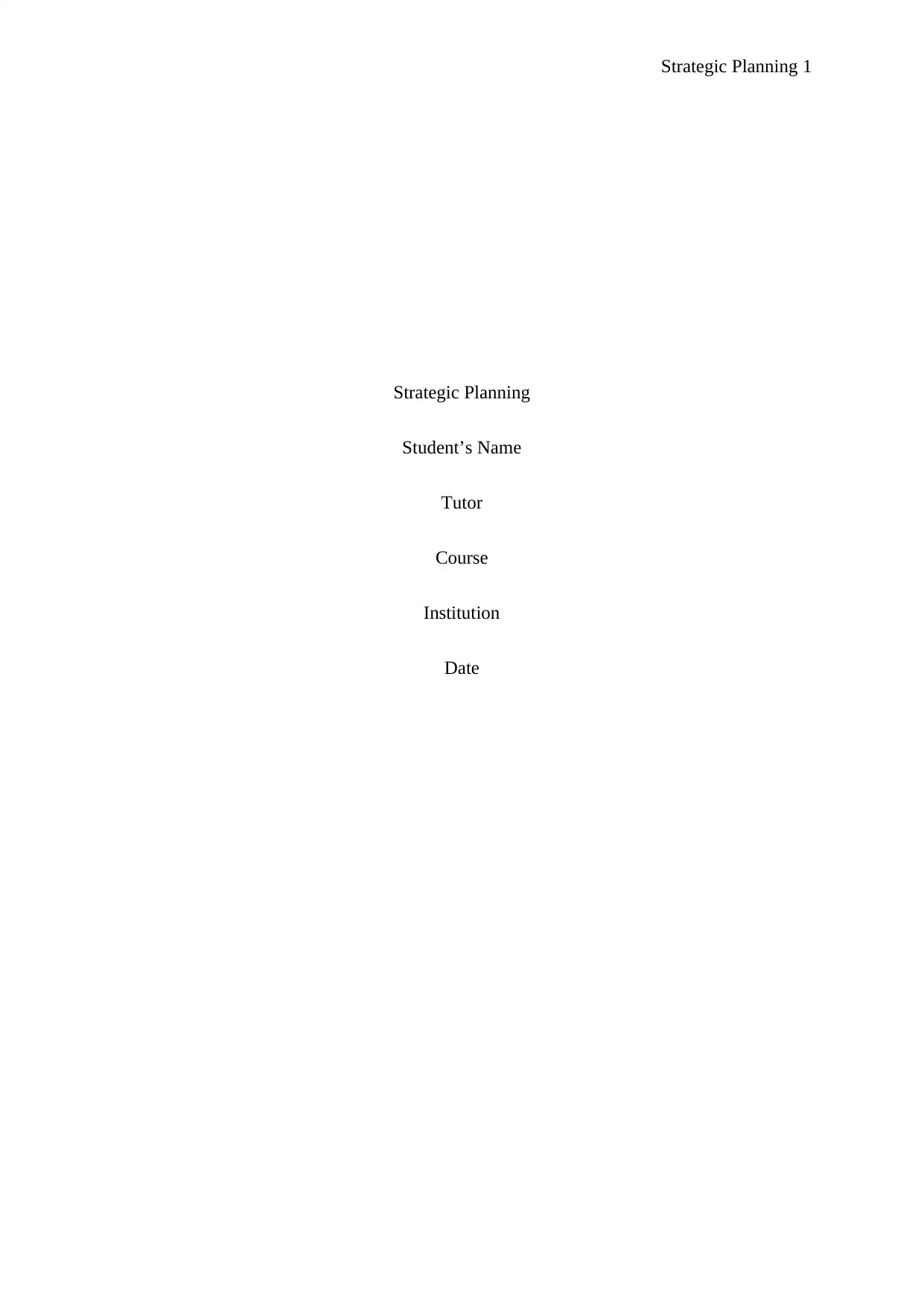
Strategic Planning 1
Strategic Planning
Student’s Name
Tutor
Course
Institution
Date
Strategic Planning
Student’s Name
Tutor
Course
Institution
Date
Paraphrase This Document
Need a fresh take? Get an instant paraphrase of this document with our AI Paraphraser
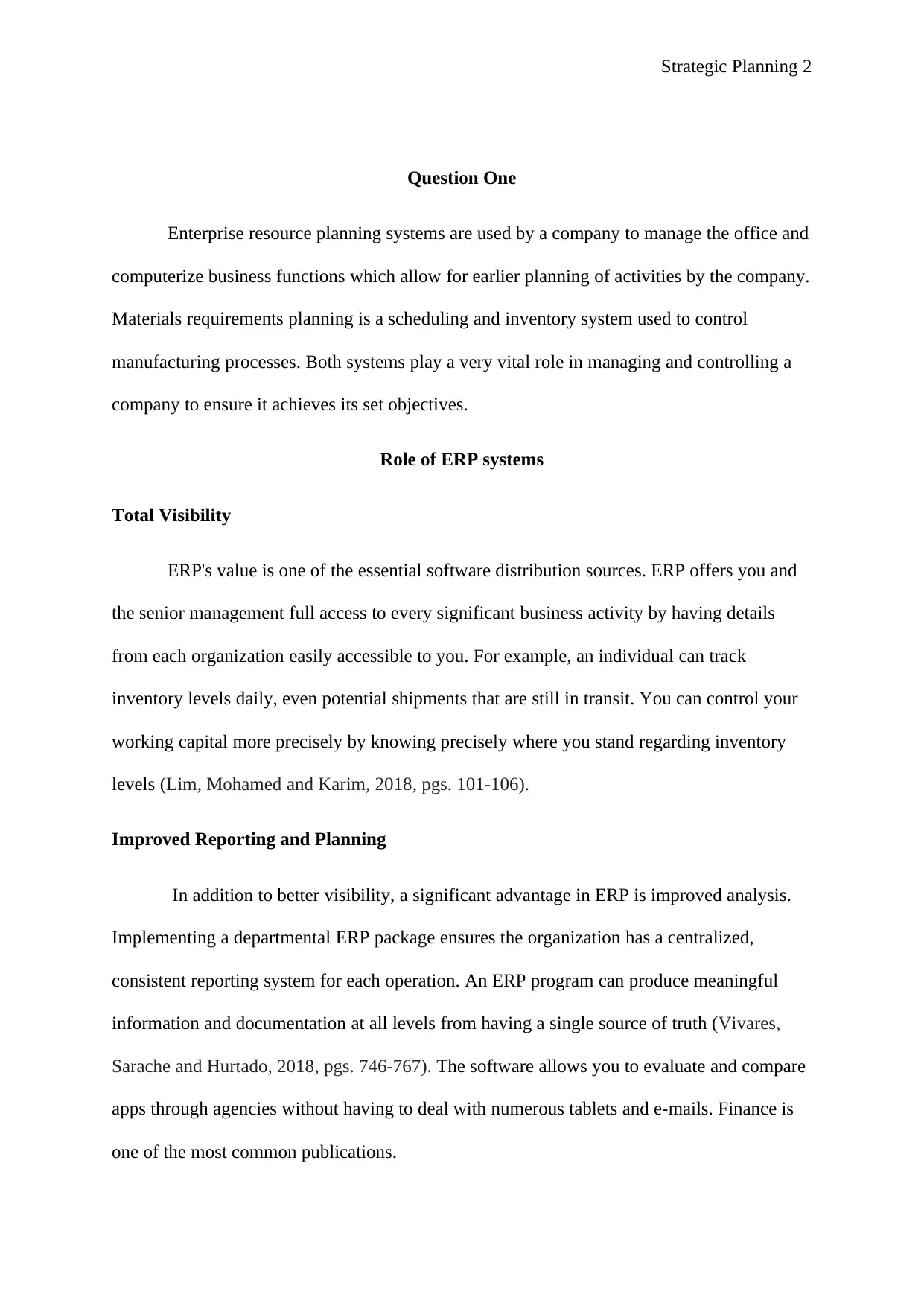
Strategic Planning 2
Question One
Enterprise resource planning systems are used by a company to manage the office and
computerize business functions which allow for earlier planning of activities by the company.
Materials requirements planning is a scheduling and inventory system used to control
manufacturing processes. Both systems play a very vital role in managing and controlling a
company to ensure it achieves its set objectives.
Role of ERP systems
Total Visibility
ERP's value is one of the essential software distribution sources. ERP offers you and
the senior management full access to every significant business activity by having details
from each organization easily accessible to you. For example, an individual can track
inventory levels daily, even potential shipments that are still in transit. You can control your
working capital more precisely by knowing precisely where you stand regarding inventory
levels (Lim, Mohamed and Karim, 2018, pgs. 101-106).
Improved Reporting and Planning
In addition to better visibility, a significant advantage in ERP is improved analysis.
Implementing a departmental ERP package ensures the organization has a centralized,
consistent reporting system for each operation. An ERP program can produce meaningful
information and documentation at all levels from having a single source of truth (Vivares,
Sarache and Hurtado, 2018, pgs. 746-767). The software allows you to evaluate and compare
apps through agencies without having to deal with numerous tablets and e-mails. Finance is
one of the most common publications. ⠀
Question One
Enterprise resource planning systems are used by a company to manage the office and
computerize business functions which allow for earlier planning of activities by the company.
Materials requirements planning is a scheduling and inventory system used to control
manufacturing processes. Both systems play a very vital role in managing and controlling a
company to ensure it achieves its set objectives.
Role of ERP systems
Total Visibility
ERP's value is one of the essential software distribution sources. ERP offers you and
the senior management full access to every significant business activity by having details
from each organization easily accessible to you. For example, an individual can track
inventory levels daily, even potential shipments that are still in transit. You can control your
working capital more precisely by knowing precisely where you stand regarding inventory
levels (Lim, Mohamed and Karim, 2018, pgs. 101-106).
Improved Reporting and Planning
In addition to better visibility, a significant advantage in ERP is improved analysis.
Implementing a departmental ERP package ensures the organization has a centralized,
consistent reporting system for each operation. An ERP program can produce meaningful
information and documentation at all levels from having a single source of truth (Vivares,
Sarache and Hurtado, 2018, pgs. 746-767). The software allows you to evaluate and compare
apps through agencies without having to deal with numerous tablets and e-mails. Finance is
one of the most common publications. ⠀
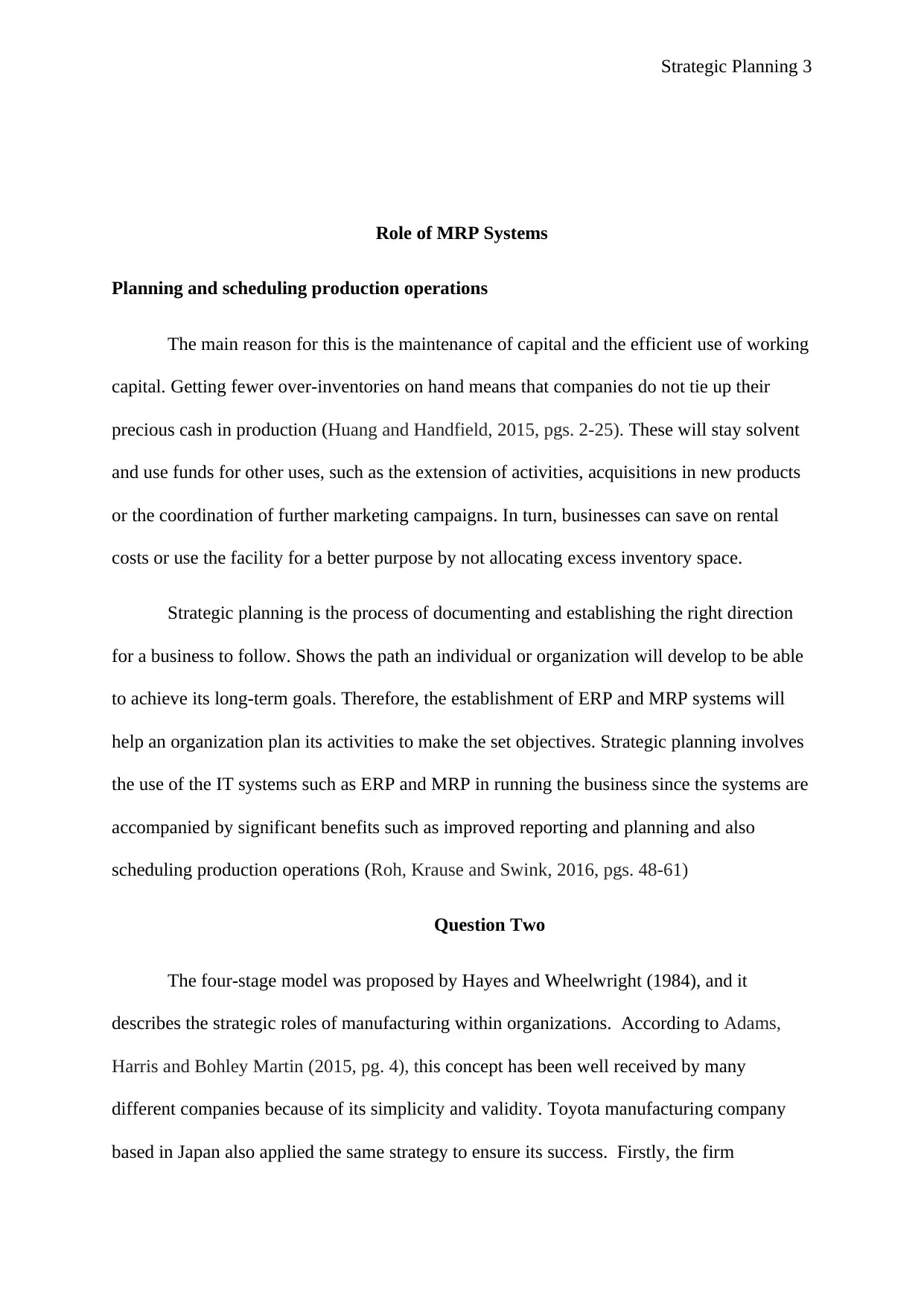
Strategic Planning 3
Role of MRP Systems
Planning and scheduling production operations
The main reason for this is the maintenance of capital and the efficient use of working
capital. Getting fewer over-inventories on hand means that companies do not tie up their
precious cash in production (Huang and Handfield, 2015, pgs. 2-25). These will stay solvent
and use funds for other uses, such as the extension of activities, acquisitions in new products
or the coordination of further marketing campaigns. In turn, businesses can save on rental
costs or use the facility for a better purpose by not allocating excess inventory space.
Strategic planning is the process of documenting and establishing the right direction
for a business to follow. Shows the path an individual or organization will develop to be able
to achieve its long-term goals. Therefore, the establishment of ERP and MRP systems will
help an organization plan its activities to make the set objectives. Strategic planning involves
the use of the IT systems such as ERP and MRP in running the business since the systems are
accompanied by significant benefits such as improved reporting and planning and also
scheduling production operations (Roh, Krause and Swink, 2016, pgs. 48-61)
Question Two
The four-stage model was proposed by Hayes and Wheelwright (1984), and it
describes the strategic roles of manufacturing within organizations. According to Adams,
Harris and Bohley Martin (2015, pg. 4), this concept has been well received by many
different companies because of its simplicity and validity. Toyota manufacturing company
based in Japan also applied the same strategy to ensure its success. Firstly, the firm
Role of MRP Systems
Planning and scheduling production operations
The main reason for this is the maintenance of capital and the efficient use of working
capital. Getting fewer over-inventories on hand means that companies do not tie up their
precious cash in production (Huang and Handfield, 2015, pgs. 2-25). These will stay solvent
and use funds for other uses, such as the extension of activities, acquisitions in new products
or the coordination of further marketing campaigns. In turn, businesses can save on rental
costs or use the facility for a better purpose by not allocating excess inventory space.
Strategic planning is the process of documenting and establishing the right direction
for a business to follow. Shows the path an individual or organization will develop to be able
to achieve its long-term goals. Therefore, the establishment of ERP and MRP systems will
help an organization plan its activities to make the set objectives. Strategic planning involves
the use of the IT systems such as ERP and MRP in running the business since the systems are
accompanied by significant benefits such as improved reporting and planning and also
scheduling production operations (Roh, Krause and Swink, 2016, pgs. 48-61)
Question Two
The four-stage model was proposed by Hayes and Wheelwright (1984), and it
describes the strategic roles of manufacturing within organizations. According to Adams,
Harris and Bohley Martin (2015, pg. 4), this concept has been well received by many
different companies because of its simplicity and validity. Toyota manufacturing company
based in Japan also applied the same strategy to ensure its success. Firstly, the firm
⊘ This is a preview!⊘
Do you want full access?
Subscribe today to unlock all pages.

Trusted by 1+ million students worldwide
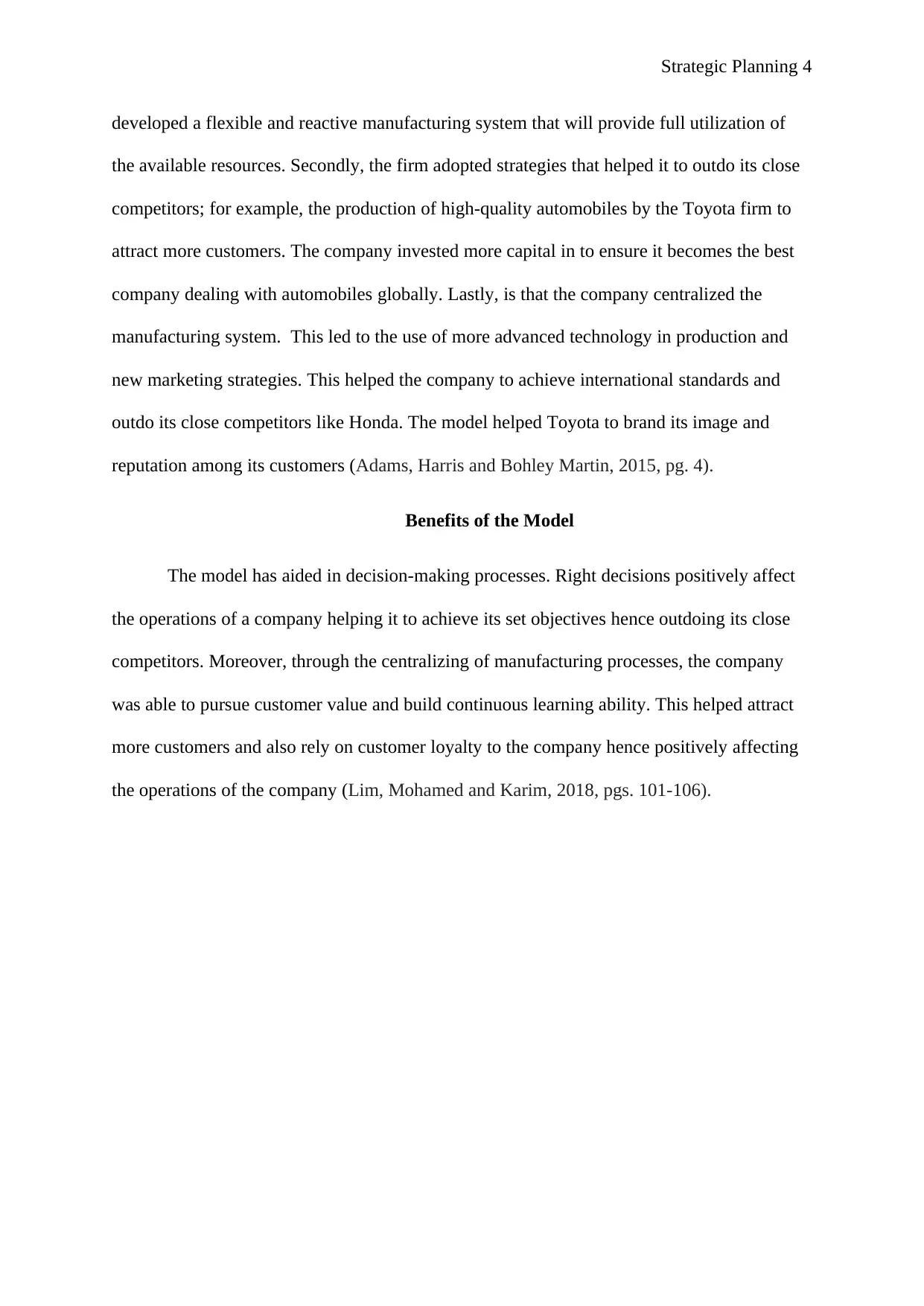
Strategic Planning 4
developed a flexible and reactive manufacturing system that will provide full utilization of
the available resources. Secondly, the firm adopted strategies that helped it to outdo its close
competitors; for example, the production of high-quality automobiles by the Toyota firm to
attract more customers. The company invested more capital in to ensure it becomes the best
company dealing with automobiles globally. Lastly, is that the company centralized the
manufacturing system. This led to the use of more advanced technology in production and
new marketing strategies. This helped the company to achieve international standards and
outdo its close competitors like Honda. The model helped Toyota to brand its image and
reputation among its customers (Adams, Harris and Bohley Martin, 2015, pg. 4).
Benefits of the Model
The model has aided in decision-making processes. Right decisions positively affect
the operations of a company helping it to achieve its set objectives hence outdoing its close
competitors. Moreover, through the centralizing of manufacturing processes, the company
was able to pursue customer value and build continuous learning ability. This helped attract
more customers and also rely on customer loyalty to the company hence positively affecting
the operations of the company (Lim, Mohamed and Karim, 2018, pgs. 101-106).
developed a flexible and reactive manufacturing system that will provide full utilization of
the available resources. Secondly, the firm adopted strategies that helped it to outdo its close
competitors; for example, the production of high-quality automobiles by the Toyota firm to
attract more customers. The company invested more capital in to ensure it becomes the best
company dealing with automobiles globally. Lastly, is that the company centralized the
manufacturing system. This led to the use of more advanced technology in production and
new marketing strategies. This helped the company to achieve international standards and
outdo its close competitors like Honda. The model helped Toyota to brand its image and
reputation among its customers (Adams, Harris and Bohley Martin, 2015, pg. 4).
Benefits of the Model
The model has aided in decision-making processes. Right decisions positively affect
the operations of a company helping it to achieve its set objectives hence outdoing its close
competitors. Moreover, through the centralizing of manufacturing processes, the company
was able to pursue customer value and build continuous learning ability. This helped attract
more customers and also rely on customer loyalty to the company hence positively affecting
the operations of the company (Lim, Mohamed and Karim, 2018, pgs. 101-106).
Paraphrase This Document
Need a fresh take? Get an instant paraphrase of this document with our AI Paraphraser
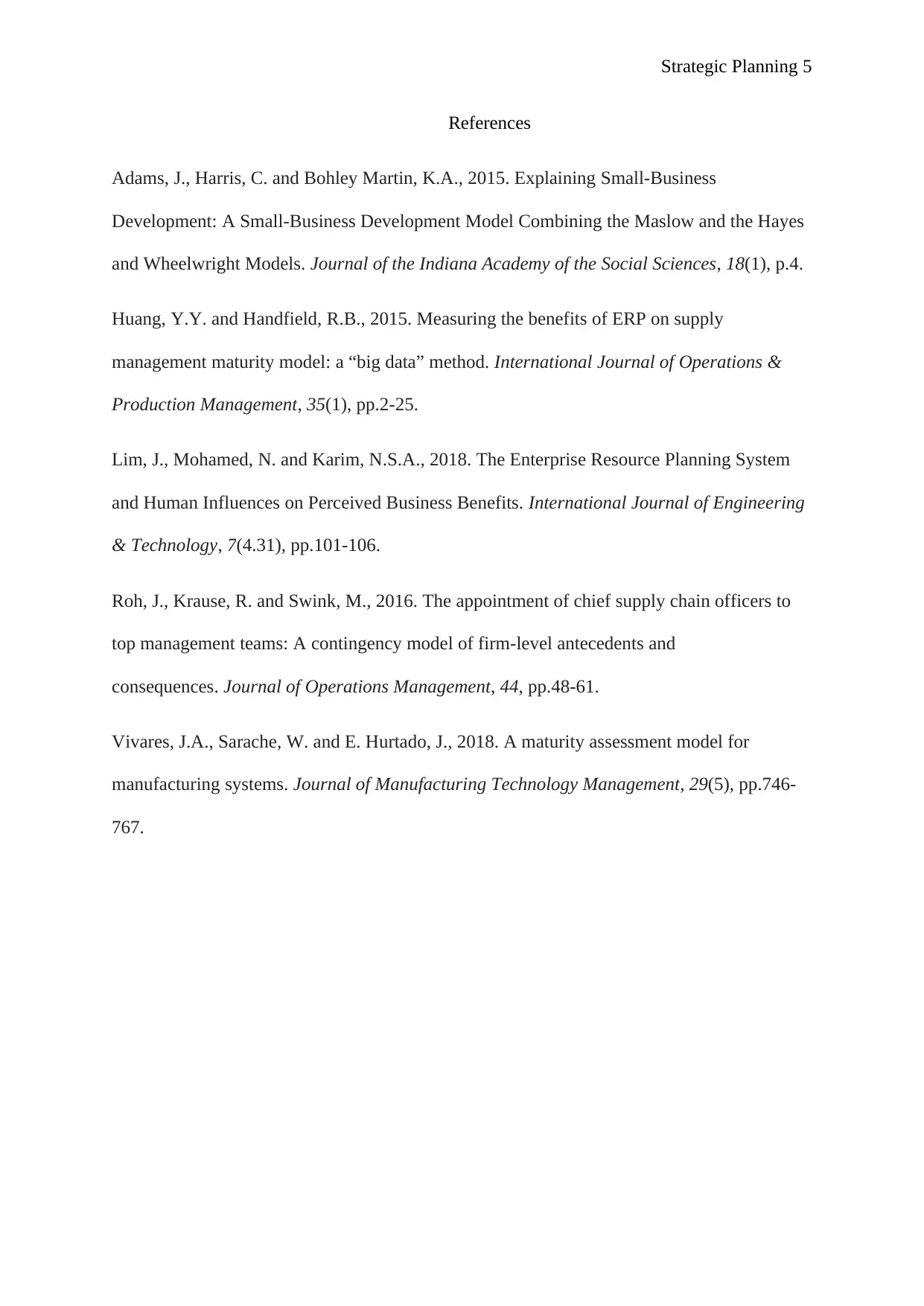
Strategic Planning 5
References
Adams, J., Harris, C. and Bohley Martin, K.A., 2015. Explaining Small-Business
Development: A Small-Business Development Model Combining the Maslow and the Hayes
and Wheelwright Models. Journal of the Indiana Academy of the Social Sciences, 18(1), p.4.
Huang, Y.Y. and Handfield, R.B., 2015. Measuring the benefits of ERP on supply
management maturity model: a “big data” method. International Journal of Operations &
Production Management, 35(1), pp.2-25.
Lim, J., Mohamed, N. and Karim, N.S.A., 2018. The Enterprise Resource Planning System
and Human Influences on Perceived Business Benefits. International Journal of Engineering
& Technology, 7(4.31), pp.101-106.
Roh, J., Krause, R. and Swink, M., 2016. The appointment of chief supply chain officers to
top management teams: A contingency model of firm-level antecedents and
consequences. Journal of Operations Management, 44, pp.48-61.
Vivares, J.A., Sarache, W. and E. Hurtado, J., 2018. A maturity assessment model for
manufacturing systems. Journal of Manufacturing Technology Management, 29(5), pp.746-
767.
References
Adams, J., Harris, C. and Bohley Martin, K.A., 2015. Explaining Small-Business
Development: A Small-Business Development Model Combining the Maslow and the Hayes
and Wheelwright Models. Journal of the Indiana Academy of the Social Sciences, 18(1), p.4.
Huang, Y.Y. and Handfield, R.B., 2015. Measuring the benefits of ERP on supply
management maturity model: a “big data” method. International Journal of Operations &
Production Management, 35(1), pp.2-25.
Lim, J., Mohamed, N. and Karim, N.S.A., 2018. The Enterprise Resource Planning System
and Human Influences on Perceived Business Benefits. International Journal of Engineering
& Technology, 7(4.31), pp.101-106.
Roh, J., Krause, R. and Swink, M., 2016. The appointment of chief supply chain officers to
top management teams: A contingency model of firm-level antecedents and
consequences. Journal of Operations Management, 44, pp.48-61.
Vivares, J.A., Sarache, W. and E. Hurtado, J., 2018. A maturity assessment model for
manufacturing systems. Journal of Manufacturing Technology Management, 29(5), pp.746-
767.
1 out of 5
Related Documents
Your All-in-One AI-Powered Toolkit for Academic Success.
+13062052269
info@desklib.com
Available 24*7 on WhatsApp / Email
![[object Object]](/_next/static/media/star-bottom.7253800d.svg)
Unlock your academic potential
Copyright © 2020–2025 A2Z Services. All Rights Reserved. Developed and managed by ZUCOL.




